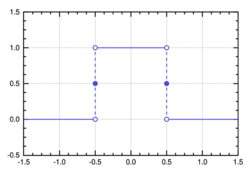Top-hat filter
The name Top-hat filter refers to several real-space or Fourier space filtering techniques (not to be confused with the top-hat transform). The name top-hat originates from the shape of the filter, which is a rectangle function, when viewed in the domain in which the filter is constructed.
Real space
In real-space the filter performs nearest-neighbour filtering, incorporating components from neighbouring y-function values. However, despite their ease of implementation their practical use is limited as the real-space representation of a top-hat filter is the sinc function, which has the often undesirable effect of incorporating non-local frequencies.
Analogue implementations
Exact non-digital implementations are only theoretically possible. Top-hat filters can be constructed by chaining theoretical low-band and high-band filters. In practice, an approximate top-hat filter can be constructed in analogue hardware using approximate low-band and high-band filters.
Fourier space
In Fourier space, a top hat filter selects a band of signal of desired frequency by the specification of a lower and upper bounding frequencies. Top-hat filters are particularly easy to implement digitally.
Related functions
The top hat function can be generated by differentiating a linear ramp function of width [math]\displaystyle{ \epsilon }[/math]. The limit of [math]\displaystyle{ \epsilon }[/math] then becomes the Dirac delta function. Its real-space form is the same as the moving average, with the exception of not introducing a shift in the output function.
See also
References
 |


